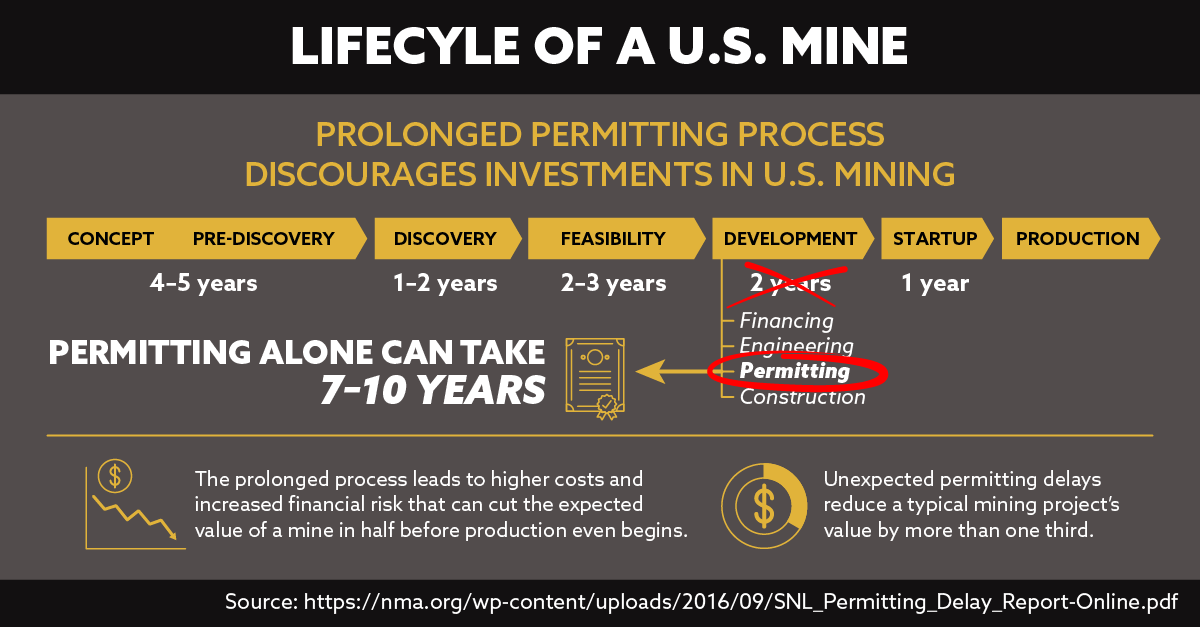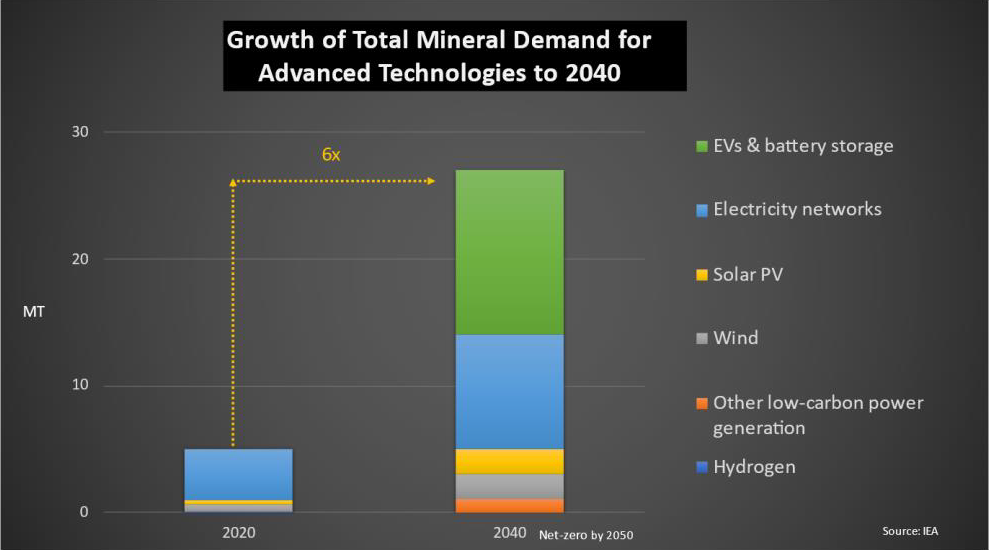Issue
The U.S. needs raw materials for power, utilities, transportation, housing, and manufacturing.
Mining provides the raw materials required for nearly every industry and consumer product, yet it takes 7 to 10 years to secure a mine permit in the U.S. – one of the longest permitting processes in the world – while in Australia and Canada, permitting takes between two and three years.i
Navigating the regulatory process to bring a mine into production is onerous and the attendant delays are costly to the national security and economic interests of the United States.
The cost of regulation and length of time needed to secure a mining permit is especially challenging with respect to critical and strategic minerals, on which the U.S. is heavily import reliant, many from adversary nations.ii
For example, the U.S. is reliant on China for 80% of its rare earth mineral needs. Such minerals are used in clean energy technologies, including advanced automotive propulsion batteries, fuel cells, electric motors, high-efficiency light bulbs, and generators in wind turbines.iii
Effective regulation and efficient permitting are crucial to conducting mining in a responsible and sustainable manner, protective of life and the environment. A more efficient permitting process resulting in faster permit decisions is needed to support the mining industry, and the U.S. economy.
Background – Mining Company Interaction with Government – How it is supposed to work
Permitting a mining project is challenging in the US and other countries, however, secure access to raw and processed minerals is important to most nations' economies and national security. The mining company applying for a permit and the government must interact successfully. Public acceptance and addressing concerns are essential. The role of the mining company and government is briefly discussed below.
The Mining Company
Mining companies extract and produce mineral raw materials that support the economy. Like other businesses, their mission is to provide return on investment to shareholders in accordance with environmental, public health and safety standards. Mining company challenges include obtaining initial permits to mine and the maintenance and continuation of operations. To do so, miners must be able to access substantial capital to explore, evaluate, design, permit, and construct a project, before breaking ground and establishing revenue. Notwithstanding such access, there is significant risk and uncertainty in any such endeavor, including financial and political risk.
In light of these risks, mining companies seek to expedite the permitting process. They must also gain the confidence of the agencies and public by demonstrating that the project, once approved, will meet all legal, environmental, safety and other requirements. The social license to operate governs successful operations through compliance with rigorous environmental standards and public engagement and acceptance.
The Government
The government includes the elected legislators, authorities appointed or staffed in governmental units, agencies, and the court system. Federal and state regulatory agencies are charged with the complex responsibility for the evaluation and issuance of decisions on mine permit applications. Changes in regulatory interpretations and governing laws driven by the political forces in the legislative arenas further influence and may complicate the process.
The Fraser Institute Annual Survey of Mining Companies 2020 evaluates 77 jurisdictions throughout the world, studying and reporting on its investment attractiveness and political risk. Minerals are where they may be found and, in many cases, are in regions that are remote and whose governance may be hostile to mining. The survey notes variability between nations such as the U.S. and Canada, for example, in the effectiveness and efficiency of its permitting system.iv
Ideally, the government fulfills its role through the following:
- Effective coordination with multiple agencies. A streamlined compliance process between state and federal agencies under the National Environmental Policy Act is essential, but often takes years to result in a final decision.
- Rules must be clear, consistent, and applied fairly. Deadlines for the review of projects must be respected.
- The balance between environmental protection and economic considerations should involve a fair process with stakeholder input.
- Adequate and continuous oversight by mining regulatory authorities and the public is also necessary to gain and maintain confidence in the mining activities.
The Reality – Permitting Delays Lead to Loss of Value
The National Mining Association reports that mining companies accept that there will always be some element of delay during the development period and will build appropriate contingency and mitigation measures into their business plans. However, protracted delays are a real problem for the industry, and by extension, the U.S. economy.

A typical U.S. mining project loses more than one-third of its value, as a result of bureaucratic delays in receiving the numerous permits needed to begin production, according to a 2015 study by SNL Metals and Mining.v The higher costs and increased risk that often arise from a prolonged permitting process can cut the expected value of a mine in half before production even begins. The combined impact of open-ended delays can lead to mining projects becoming altogether financially unviable.
Despite having the world's most advanced economy and abundant mineral reserves, the U.S. accounts for only 11% of worldwide mineral exploration dollars. This has resulted in increasing U.S. reliance on imports of minerals, particularly those needed for national defense and advanced clean energy technologies – including wind, solar, and the manufacture of electric vehicles. These technologies require vastly more materials than traditional fossil fuel-based technologies.

Thus, permitting delays result in more than a loss of value to mining companies. These delays, which can result in the cancellation of projects, increase reliance on imported minerals. Imports made up more than one-half of U.S. consumption for 46 nonfuel mineral commodities and the United States relied entirely on imports for 17 of those. Of those 17, 14 are identified as critical minerals. Another 14 critical minerals had a net import reliance greater than 50 percent, most of which were supplied to the U.S. by China.vi
In December 2019, the Center for Strategic and International Studies (CSIS) and the Blue Green Alliance (BGA) brought together a group of stakeholders to examine a path forward for a critical minerals strategy. The group noted, "Today, the United States lacks strategies for responsibly mining these materials at home, for developing sustainable supply chains for their incorporation into the clean energy economy, and for leading through example and cooperation with other nations that seek to mine and develop these resources in safe, environmentally responsible, and socially inclusive ways."
What Accounts for Permitting Delays in the United States?
As outlined in the SNL study, the process of complying with the National Environmental Policy Act and other laws result in permitting delays that can easily exceed 10 years. A company must also often change mine designs as a requirement of the permitting process, forcing agencies to re-evaluate the new mine plan. That results in extended time periods. Thus, SNL reports as follows:
“In summary, U.S. mining projects require multiple permits and multiple agency involvement, as well as involvement of other stakeholders...NEPA analyses...are often the lengthiest step in the permitting process due to a lack of agency coordination and unconstrained time frames.”vii
Other countries like Canada define the roles and responsibilities of the agencies involved in permitting at the outset and timeline-based targets are agreed to and published at the start of the application process. Thus, “all parties involved have a predictable time schedule by which approval/denial of the required permits is expected.”
SME Statement of Technical Position
The world and especially the United States need a steady and secure supply of raw materials including mineral products. A rigorous but efficient process to evaluate proposed projects is a foundation to address those needs:
- Delays in the issuance of mining permits increase U.S. dependence on imports of minerals, especially critical and rare earth minerals, from nations whose interests may be averse to the U.S.
- The U.S. must develop a sound, national strategy to expedite the process for the issuance of permits for mining operations and reduce the length of time that is currently required to bring a mine into production. The U.S. should study the permitting programs in Canada and Australia and consider them as a model for adopting changes.
- Collaboration and consistency between and within federal and state agencies is needed.
- The Federal Permitting Improvement Steering Council's (FPISC) rule to add mining as a sector eligible for coverage under Title 41 of the Fixing America's Surface Transportation Act (FAST–41) is an important step forward in expediting the approval of major mining projects that exceed certain cost thresholds.viii
Notes/References
i U.S. Minerals Mining – The Heart of our Economic Recovery and a Prosperous Future (2020) www.nma.org; DELAYS IN THE U.S. MINE PERMITTING PROCESS IMPAIR AND DISCOURAGE MINING AT HOME
ii Minerals and Materials, U.S. Department of Energy's Strategy to support Domestic Critical Mineral and Mineral Supply Chains (FY2021-2031)
iii V. McLemore, Rare Earth Elements, https://www.smenet.org/What-We-Do/Technical-Briefings/Rare-Earth-Elements
iv Yunis, Jairo, and Elmira Aliakbari (2021). Fraser Institute Annual Survey of Mining Companies 2020. Fraser Institute. http://www.fraserinstitute.org
v SNL Metals and Mining, Permitting, Economic Value and Mining in the United States (2015).
vi See, Mineral Commodity Summaries 2021 at 5-6; https://pubs.usgs.gov/periodicals/mcs2021/mcs2021.pdf
vii SNL Study at 25.
viii 86 FR 1281 (Jan. 8, 2021) https://www.federalregister.gov/documents/2021/01/08/2021-00088/adding-mining-as-a-sector-of-projects-eligible-for-coverage-under-title-41-of-the-fixing-americas
